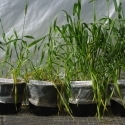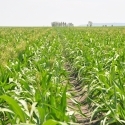24 Sep 2012
Multiple nutrient deficiencies in northern grains cropping
Importance of considering K, as well as N, P and S in a nutrition program.
 Brookstead research site, southeastern Queensland.
Brookstead research site, southeastern Queensland.
The northern cropping zone is dominate by heavy clay soils which had substantial nutrient reserves. Under modern cropping systems, these reserves have been reduced and the efficient use of water in depends on adequate nutrition, which together with good overall agronomy are the cornerstones of sustainable production.
Nutrient removal, especially of K and S has increased with better farming practices, although little attention is given to replacing these nutrients. It is anticipated that soils will become K and S responsive where they have lower initial reserves (eg box soils compared to alluvial soils, or open downs soils compared to scrub soils), and where the land has a long history of cropping and where high K demanding crops like cotton are grown.
Many of the key northern grain and cotton producing regions are dominated by vertosols (black and gray cracking clays). While these soils can hold a lot of water, annual productivity is extremely reliant on stored subsoil moisture, particularly for winter crops. The nutrients provided from these subsoils are critical to the extraction and use of profile water. Soil tests for K (ammonium acetate extractable K) on these soil types do not seem to give a good indication of response due to variable levels of "slowly available" K. The presence of other cations, particularly sodium (Na) and magnesium (Mg) affect the interpretation of the soil test for K. The critical values are also affected by the cation exchange capacity (CEC) of the soil, with higher CEC soils (clays for example) showing higher critical values.
Strip trials and even controlled experiments are common ways to diagnose nutrient responses. An area of the paddock is treated with the nutrient suspected of being in short supply, and growth and yield measurements are made to see if the crop responded to the added nutrient.
Research in the northern grain zone has shown that subsoils, as well as topsoils are often deficient in not just K, but also phosphorus (P) and sulfur (S), so a test-strip of added K may not show any response. Research has moved to investigate multiple nutrient trials, where responses are only seen where the multiple nutrient limitations are addressed.
To overcome this depletion, deep placement of a combination of these nutrients is giving good results, especially when care is also given to nitrogen. The results of deep placement rely on seasonal rainfall patterns, but the deeper nutrients have shown better residual effects. The trick is how to put enough nutrients in the right place to meet the requirements of heavy K users such as cotton, while still keeping soil disturbance to a minimum.
This research is be being led by Dr Mike Bell (Queensland Alliance for Agriculture and Food Innovation), David Lester (Queensland Department of Employment, Economic Development and Innivation) and a range of other researchers. It is supported by the Grains Research and Development Corporation, the Cotton Research and Development Corporation, Canpotex, Agrow P/L and IPNI.




